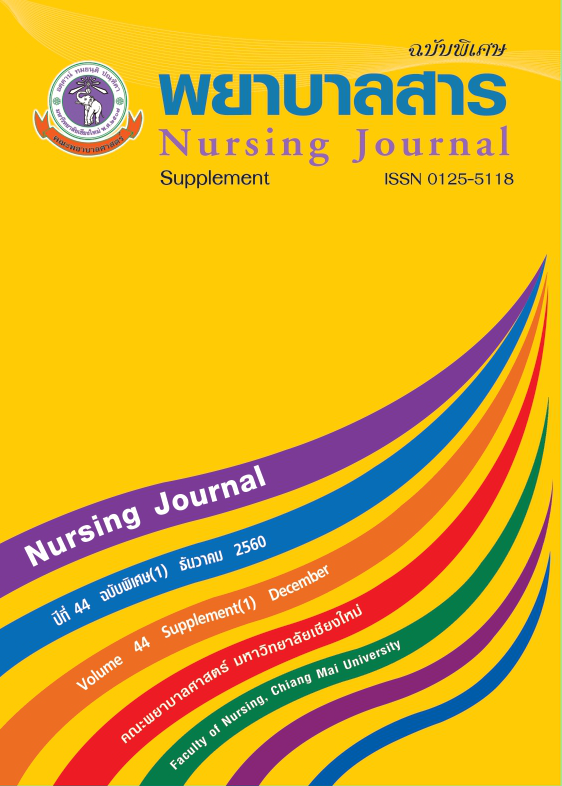Factors Related to Kangaroo Mother Care Promotion for Preterm Infants
Keywords:
Kangaroo Mother Care, Preterm Infants, Related FactorsAbstract
Kangaroo mother care for preterm infants is physically and psychologically beneficial for mothers and infants. This descriptive research aimed to study the promotion of kangaroo mother care of preterm infants in neonatal wards, and related factors in nursing practice. The samples consisted of: (1) 106 nurses who worked in neonatal wards, (2) 88 preterm infant mothers, and (3) 26 administrators or supervisors. Data were collected in 4 northern tertiary hospitals from October 2014 to January 2015. The research instruments used were (1) nursing practice of kangaroo mother care promotion for preterm infants questionnaire, and (2) the related factors of kangaroo mother care promotion questionnaire for each sample, which were developed by the researcher. Data were analyzed using descriptive statistics, Spearman correlation coefficient and Pearson correlation statistics.
The findings revealed that: The average score for nursing practice of kangaroo mother care promotion for preterm infants was at a high (62.3 %) and a moderate level (36.8 %). Attitude, experiences, support from administrators / supervisors and workload responsibility of the nurses as perceived by nurses were significantly related to nursing practice of kangaroo mother care promotion (p < .01 and p <.05) but the nurses’ knowledge on kangaroo mother care was not statistically significantly related to nursing practice. Attitude, readiness of mothers, maternal opinion on preterm infant characteristics and maternal perception of support from medical staff as perceived by mothers were significantly related to nursing practice of kangaroo mother care promotion (p < .05), but the mothers’ knowledge on kangaroo mother care was not significantly related to nursing practice. Policies, nursing guidelines, instruments provided for kangaroo mother care promotion, appropriate workload allocation as perceived by administrators or supervisor were not significantly related to nursing practice on kangaroo mother care promotion.
The results of this study can be used as basic information for nurses to enhance nursing practice of kangaroo mother care promotion for preterm infants.
References
Beck, S., Wojdyla, D., Say, L., Betran, A. P., Merialdi, M., Requejo, J. H., et al. (2010). The worldwide incidence of preterm birth: A systematic review of maternal mortality and morbidity.
Bulletin of the World Health Organization, 88(1), 31-38. doi: 10.2471/BLT.08.062554
Blencowa, H., Cousens, S., Oestergaard, M. Z., Chou, D., Moller, A. B., Narwal, R., et al. (2012). National, regional and worldwide estimates of preterm birth rates in the year 2010 with time trends for selected countries since 1990: A systematic analysis and implications. The Lancet, 379(9832), 2162-2172. doi: 10.1016/S0140-6736(12)60820-4
Blomqvist, Y. T., Frolund, L., Rubertsson, C. & Nyqvist, K. H. (2013). Provision of kangaroo mother
care: Supportive factors and barriers perceived by parents. Scandinavian Journal of Caring Sciences, 27(2), 345–353. doi: 10.1111/j.1471-6712.2012.01040.x
Byaruhanga, R. N., Bergstrom, A., Tibemanya, J., Nakitto, C., Okong, P. (2008). Perceptions
among post-delivery mothers of skin-to-skin contact and newborn baby care in a periurban hospital in Uganda. Midwifery, 24(2), 183-189.
Center for Healthcare Research & Transformation (CHRT). (2010). Prematurely. Retrieved
March 20, 2012, from http://www.chrt.org/assets/price-of-care/CHRT-Issue-Brief-November-2010.pdf.
Charpak, N. & Ruiz-Pelaez, J. G., (2006). Resistance to implementing kangaroo mother care in
developeing counties and proposed solution. Acta Paediarica, 95(5), 529-534.
Chia, P., Sellick, K., & Gan, S. (2006). The attitudes and practices of neonatal nurses in the use
of kangaroo care. Australian Journal of Advanced Nursing, 23(4), 20-27.
Eksirinimit, T. (2012). A longitudinal evaluation of Kangaroo Care for preterm infants in Thailand.
Doctor thesis. Australia, Flinders University.
Franklin, C. (2006). The Neonatal Nurse's Role in Parental Attachment in the NICU. Critical Care
Nursing Quarterly, Jan-Mar, 29(1), 81–85.
Flynn, A., & Leahy-Warren, P. (2010). Neonatal nurses’ knowledge and beliefs regarding
kangaroo care with preterm infants in an Irish neonatal unit. Journal of Neonatal Nursing, 16(5), 221-228. doi: 10.1016/j.jnn.2010.05.008
Hake-Brooks, S. J., Anderson, G. C. (2008). Kangaroo care and breastfeeding of mother-preterm infant
dyads 0-18 months: A randomized, controlled trial. Neonatal Network. 27(3), 151-159.
Johnson, A. N. (2007). Factors influencing implementation of kangaroo holding in a special care
nursery. The American Journal of Maternal Child Nursing, 32(1), 25-29.
Klaus, M. H & Kennell, J. H. (1982). Parent-infant bonding (2nded.). St.Louis: Mosby.Ladewig, P. W., London, M. L., & Davidson, M. R. (2006). Contemporary maternal-newborn nursing care. (6 th ed.). New Jersey: Pearson Education.
Ludington-Hoe, S. M., Morgan, K., & Abouelfettoh, A. (2008). A Clinical Guideline For Implementation
of Kangaroo Care With Premature Infants of 30 or More Weeks’Postmenstrual Age.
Advances in Neonatal Care, 8(3), 3–23.
Mori, R., Khanna,R., Pledge, D & Nakayama, T. (2010). Meta-analysis of physiological effects of
skin-to-skin contact for newborns and mothers. Pediatrics International, 52(2), 161–170.
Panbangpra, S. & Sangperm, P. (2013). Knowledge, Attitude, and Practice of Breastfeeding Promotion among Nurses in Private Hospitals. Journal of Nursing Science, 31(1), 70-79.
Pratomo, H., Uhudiyah, U., SigitSidi, I. P., Rustina, Y., Suradi, R., Bergh, A. M., et al. (2012).
Supporting factor and barriers in implementing kangaroo mother care in Indonesia. PaediatricaIndonesiana, 52(1), 43-50. doi: 10.14238/pi53.1.2012.09
Promkeawngam, J., Jintrawet, U. & Soontornchai, P. (2011). Kangaroo Care Practiced for Preterm Infants by Nurses Including Relative Factors. Nursing Journal, 38(3), 42-60.
Solomons, N., Rosant,C.(2012). Knowledge and attitudes of nursing staff and mothers
towards kangaroo mother care in the eastern sub-district of Cape Town. South African Journal of Clinical Nutrition, 25(1), 33-39.
Veras, R. M. &Traverso-Yepez, M. (2011). The Kangaroo Program at a Brazilian maternity
hospital: the preterm / low-weight babie’ health-care under examination. Nursing Inquiry,
18(1), 84-91.
Wiliphan, P. (2008). Practice of nurses in promoting hospitalized child's development and
related factors ;Practice of nurses in promoting hospitalized child's development and related factors.The Thesis Master of Nursing Science Program in Pediatric Nursing, Graduate School, Chiang Mai University.
World Health Organization. (2003). Kangaroo mother care – a practice guide. Department of
reproductive health and research, WHO, Geneva.
Downloads
Published
How to Cite
Issue
Section
License
บทความที่ได้รับการตีพิมพ์เป็นลิขสิทธิ์ของวารสารพยาบาลสาร
ข้อความที่ปรากฏในบทความแต่ละเรื่องในวารสารวิชาการเล่มนี้เป็นความคิดเห็นส่วนตัวของผู้เขียนแต่ละท่านไม่เกี่ยวข้องกับมหาวิทยาลัยเชียงใหม่ และคณาจารย์ท่านอื่นๆในมหาวิทยาลัยฯ แต่อย่างใด ความรับผิดชอบองค์ประกอบทั้งหมดของบทความแต่ละเรื่องเป็นของผู้เขียนแต่ละท่าน หากมีความผิดพลาดใด ๆ ผู้เขียนแต่ละท่านจะรับผิดชอบบทความของตนเองแต่ผู้เดียว






